It’s springtime! The first flowers are popping up in the garden spreading happiness and in me a prehistoric feeling of hope and reawakening. Our garden has erupted into a delicate firework of white snowdrops (Galanthus nivalis), purple crocuses (Crocus vernus sp.) and yellow winter aconite (Eranthis hyemalis).
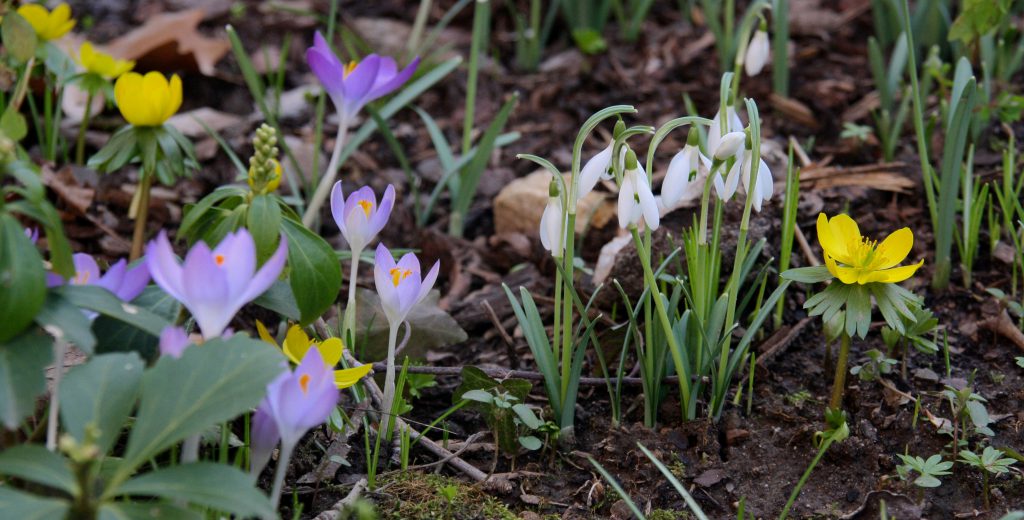
It is even warm enough for the first bees to come out and start collecting nectar and for me to crouch down in the garden and watch their miniature perfection at work.
Now that I’ve brought up bees, I could bring up the sad story of how bees and pollinators in general are dramatically declining (Germany lost 75% of its insect biomass over the last 27 years), that this is mostly due to mites, habitat loss and particular pesticides sold by big companies with powerful lobbies.
Or I could write about how public awareness for pollinator conservation has become huge. And it has become easy, fashionable even, to help pollinators do better. And today I want to tell you what you can do to help save the pollinators.
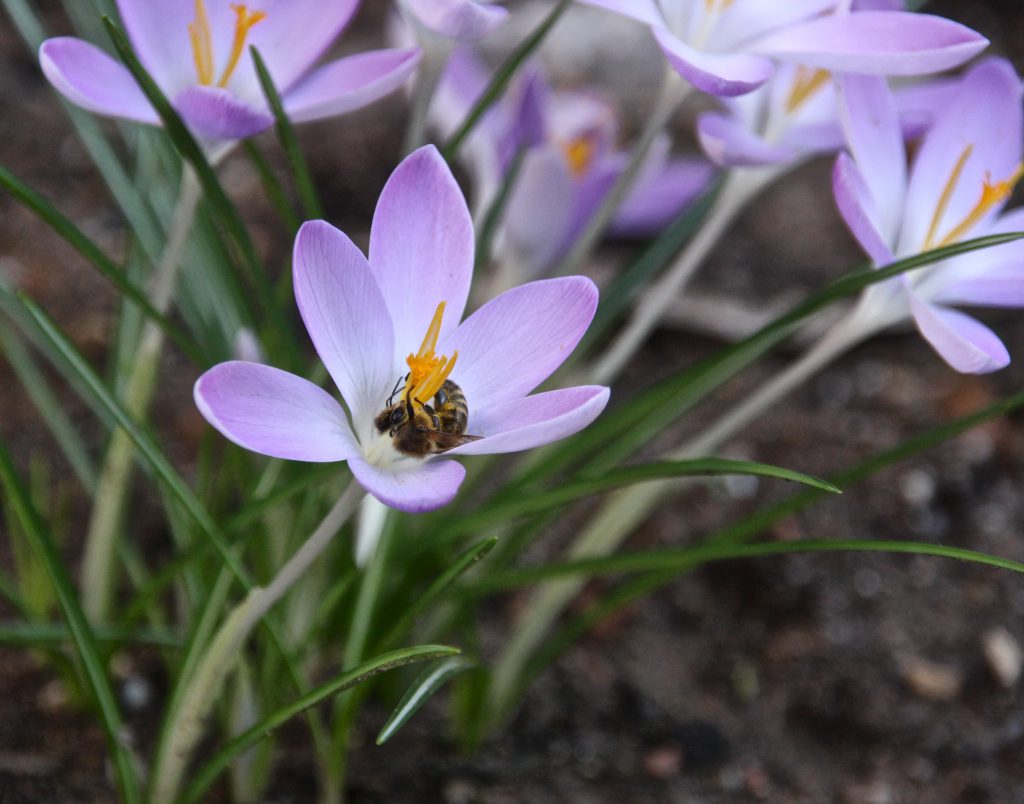
Its pretty simple actually: Plant flowers. If you don’t have a garden, plant them in boxes on your balcony or your windowsill, image-search “DIY vertical garden” (use ecosia.org instead of google and help plant trees) and get inspired. See if it is possible to create a green roof on your house. Go guerilla planting an sow seeds in public green spaces and empty, ugly spaces. Get kids to join in and experience the joy when it works and the first sprouts pop up.
Choosing the best flowers to plant
So it turns out, not all flowers are created equal and some have more value to pollinators than others. If you live in a place where the save-the-bees-thing has already taken off, there is a good chance you will find ready-to-go seed mixes especially for bees and butterflies. You are my personal hero if you go a step further and make sure that the flowers you are sowing (especially if not on your private property) are native species. I’ve made a limited list of good flower candidates below, but there are many more good species to explore.
Whatever you do, if it is a native, flowering species that has not been bred into something overly domesticated, it’s good. Some over-bred species do not have pollen or nectar, they just look pretty and force you to buy new plants every year.
Flowers are good for bees and for your soul. Colours make us happy and lots of green takes away our stress and lowers our chance of heart attack by 30% (I watch a lot of TED talks – So much interesting random information)
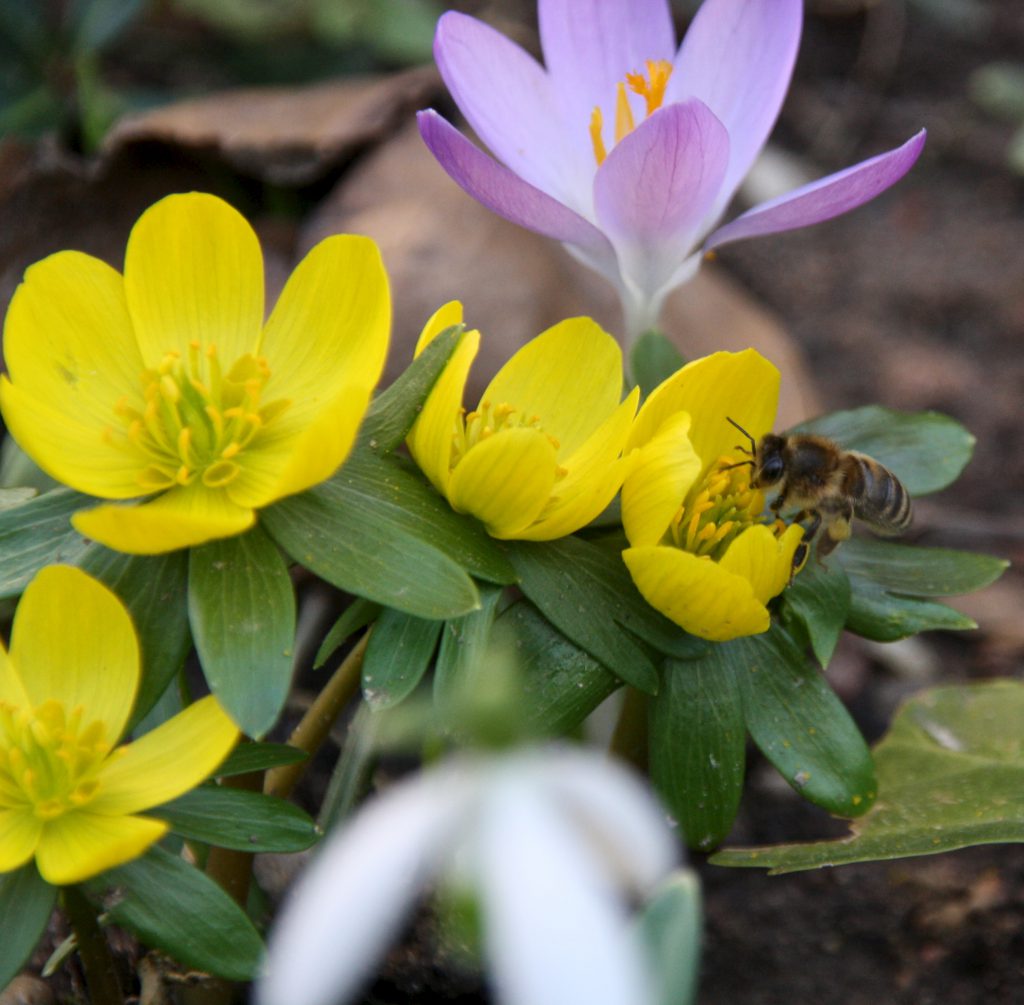
Some helpful rules:
- Plant a variety of native species.
- Plant individual species in bunches (some bees stick to one flower species until its blooming period is over, so planting in bunches increases efficiency for individual bees).
- When selecting your flower species, make sure you have something blooming for every season.
- Remember that trees also have flowers. They are often tiny and inconspicuous, however, they are plentiful on a big tree and if you listen carefully, you might hear the tree buzz.
- Avoid using chemicals in your garden. If you have a healthy garden full of native species, it will likely be able to defend its self from pests without your help. If not, try spraying with vinegar water or lemon juice. Manure and compost make good natural fertilizers.
- Many bee species nest underground. Avoid using weed cloth or heavy mulch and allow for some “nature mess” in your garden.
Prepare to see a wide variety of bees. Honey bees are not the only species out there. Many are not even black and yellow but perhaps shiny green or huge and velvety black. You will also attract many other species like butterflies and other flying insects. If you live in the Americas or anywhere tropical, you may also attract nectar drinking birds like hummingbirds or sunbirds.
I recommend buying a camera with a good macro lens, because the mini world is vast and beautiful.
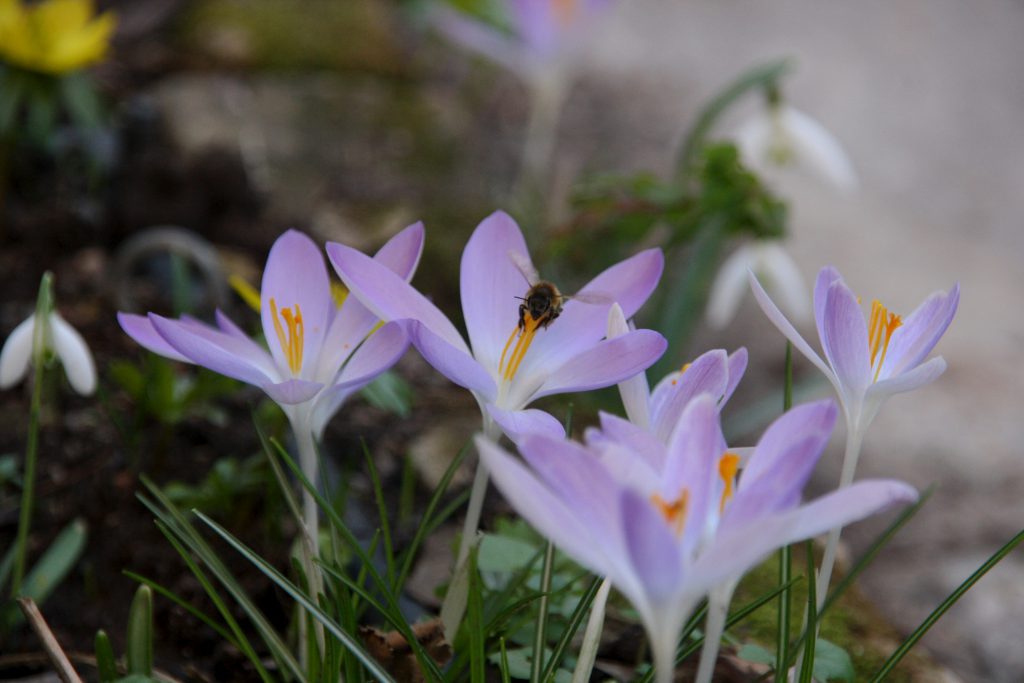
Short List of Good Bee Plants
Eurasia
- Aster (Aster sp.). There are several species of aster. Check which species are local to your area. In general, asters like it dry and sunny.
- Sage (Salvia officinalis), Thyme (Thymus vulgaris) and Rosemary (Rosmarinus officinalis) Are all native to the mediterranian but are found in herb gardens everywhere. Essential for many tasty European dishes, they also have medicinal value. A tea of sage will soothe your sore throat. Toast with fresh Thyme leaves, raw garlic and lots of honey make a surprisingly tasty cough treatment. Just don’t try to kiss anyone after.
- Fennel (Foeniculum vulgare) yet another herb, with a licorice-y taste. Together with cumin and anise, it makes nice tea that soothes the digestive tract. It was native to the Mediterranean, but is has become naturalized in many parts of the world.
- Ivy (Hedera helix). Once mature, ivy also provides winter food and a hiding place for many small birds. This species is native to Turkey and the entire EU (excluding Scandinavia north of Oslo), however there are other species that range into central Asia.
- Coriander / Cilantro (Coriandrum sativum). There is a 10% chance, that you are genetically predestined to find that the leaves taste of soap and not lemony. I’m definitely one of these soap tasters. I love the seeds though. Ground up, they make a very special spice, especially useful when you are trying to make a vegan version of a meat dish. This plant is probably originally form southern Europe / western Asia. Very popular in middle eastern and south east Asian dishes.
- Borage (Borago officinalis) although its fuzzy, prickly appearance does not make it obvious, borage is edible. The Germans make soup out of it an the traditional Grüne Soße (green sauce), the Italians stuff pasta with it, the flowers look pretty in a salad. It is native to the Mediterranean but well established throughout most of Europe. I harvest it in the German fields and even up in the forest.
- Lavender (Lavendula sp.). Probably my favourite flower. It smells so good! Essential lavender oils are said to have a nerve calming effect. Harvest the flowers and dry for a nice “sleepy time” tea. Make lavender sachets to keep moths out of your woolly pullovers.
- Calendula aka Marigold (Calendula sp.). Native to southwestern Asia, western Europe, and the Mediterranean. Has been used as a medical plant since forever. Its probably in your face cream. You can decorate your salad with the petals.
- Crocus (Crocus sp.) native so southern Europe and the middle east. Saffron comes from one particular species. Crocuses are poisons. Wash your hands if you have been picking them. I love them because they are some of the first spots of colour to come up in spring.
- Snowdrop (Galanthus sp.) The ultimate “winter is about to end”-messenger. Often found at the foot of trees and in less sunny places. You can selectively dig up some bulbs and transplant them to help them spread. There are around 20 different species ranging from France to Moscow and to Iran.
- Wild malva (Malva sylvestris). This one is particularly good for sowing in unused land throughout your community. Their seedpods are relatively easy to harvest and re-sow the following year.
- Trees like willows, fruit and nut trees, chestnuts, maples and ash trees are also great.
Here is a planting guide written for Great Britain, however most of the species named in it occur in most of Europe and some of Asia.
North America
If you live in Canada or USA or northern Mexico, check out these simple planting guides tailored to your climate and precise area.
- Sunflower (Helianthus annuus) Originally from North America, sunflowers are naturalized almost all over the world. A sunflower is pretty good at removing CO2 from the atmosphere. If you let the “dead” flower heads be over winter, many garden birds will thank you for ha high energy snack in times of need.
- Zinnia (Zinnia sp.) naturally occur in dry shrub and grasslands, especially in Mexico. They are popular decorative plants, due to their great variety in colour.
- Eastern purple coneflower (Echinacea purpurea). Like the Zinnia, this is a pretty colour intesive flower native to the eastern North America. Some Native Americans use this plant to treat all kinds of problems. It is found in commercial medicines that boost the immune system.
- Prairie Dock (Silphium terebinthinaceum) Is native from northern Missouri to southern Michigan. This plant is mildly toxic, however it has many uses in Native American medicine.
- Blanketflower (Gaillardia aristata) naturally occurs from the Yukon to California and all the way to Connecticut, but is also imported to South America and Europe. Like the previous three species, they look great in your garden.
- Butterfly weed (Asclepias tuberosa) is found in eastern North America. As the name implies, it is the host plant for the famous Monarch butterfly. It also attracts other insects and hummingbirds.
- Great blue lobelia (Lobelia siphilitica) is a gorgeous blue flower from central to eastern Canada and USA.
- Trees like native maple and willow species, fruit and nut trees have food for you and the insects.
Australia
Australian flora is not my forte at all, but I found this blog entry by “Bob the Bee Man” that has a list of Australian native plants loved by bees.
Africa
Little is known about pollinators in relation to wild plant species of Africa. Stick to the helpful rules listed above for your garden. Search the plant species in your garden online to see their native range. Support agroforestry projects and small scale, traditional farming with crop rotation and avoid mono-culture farming.
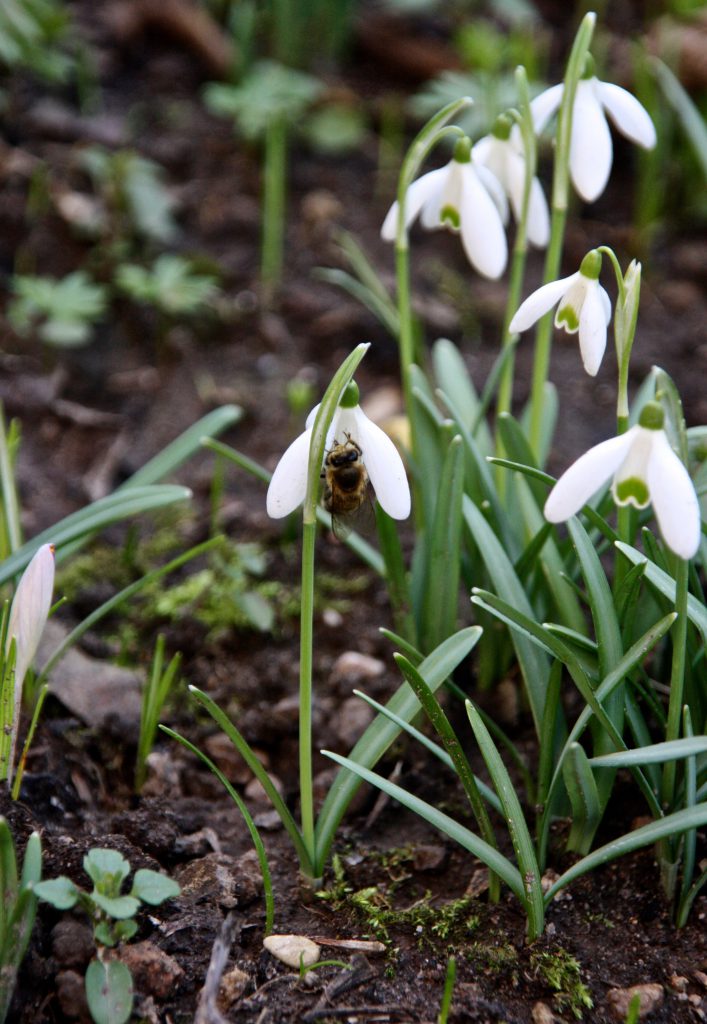


Nice Read. Good work!
Beautiful zoomed in photos of the first spring floweres and happy bees!
Two weeks ago despite the still cold nights, I was brave and put my lemon trees full of lemons and Lots of blossoms outside against a sunny wall, and 10 minutes later the bees had discovered it and were busy crawling in and out of the blossoms creating even more future lemons.